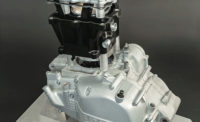Natural Fibers May Hold the Key to Lightweighting

This sunroof frame made out of natural fiber weighs 50 percent less than a traditional metal component. Photo courtesy International Automotive Components Group
As automakers and suppliers search for new ways to reduce vehicle weight, some engineers are experimenting with natural fibers. Bamboo, cotton, hemp, jute, kenaf, rice and other crops can be used to produce high-strength composite structures for automotive applications.
Ford Motor Co. is already a leader in using sustainable materials. For instance, rice hulls are used to reinforce plastic in F-150 pickup truck wiring harnesses. Wheat straw is used in the Flex full-size SUV to reinforce storage bins.
In addition, cellulose tree fibers are used in the armrest of the Lincoln MKX mid-size crossover SUV. Ford uses it to replace glass-filled plastic and claims that the material weighs 10 percent less, is produced 30 percent faster and reduces carbon emissions. The automaker is also bullish on bamboo.
“Soon, some surfaces inside our vehicles could be made from a combination of bamboo and plastic to create super hard material,” says Janet Yin, a materials engineering supervisor at Ford’s Nanjing Research and Engineering Center.
“Bamboo is amazing,” explains Yin. “It’s strong, flexible, totally renewable and plentiful.”
Yin and her colleagues have been studying the potential of using bamboo in vehicle interiors. She claims it’s possible to make extra strong parts by combining the natural fiber with plastic.
“Bamboo performs comprehensively better than other tested synthetic and natural fibers, from tensile strength tests to impact strength tests,” says Yin. “And, it has been heated to more than 212 F to ensure it can maintain its integrity.”
Tier One suppliers are also exploring the potential of using natural fibers. Engineers at International Automotive Components Group (IAC) recently developed a sunroof frame that’s lighter than traditional alternatives.
“The FiberFrame replaces the sun roof’s metal reinforcement frame by employing strong, natural fibers using a new raw material comprised of 70 percent renewable content, while improving the frame’s structural rigidity,” says Rose Ryntz, vice president of advanced development and materials engineering at IAC.
“This lightweight solution is reinforced using [our] EcoMatHot natural fiber-based semifinished mat material, which was especially developed for this application,” adds Ryntz. “The fiber mat is molded with a thermoset binder and is manufactured in-house in a hot-molding process.”
A startup company called Natural Fiber Welding Inc. (NFW) is also in the process of commercializing a new way to produce lightweight automotive components. The fiber welding process, developed by engineers at the U.S. Air Force Research Laboratory, has been successfully used with cotton, hemp, flax, jute and sisal.
Natural fiber welding is a process in which individual fibers are swollen by an appropriate ionic liquid-based solvent system to form a congealed network. It is controlled by the composition of the solvent system, which includes a liquid solvent plus additives such as methanol and water. Conditions, such as the amount and placement of solvent, and process variables, such as time, temperature and pressure, control the extent to which fibers are fused.
“Polymers from neighboring natural fibers interact and individual fibers are ‘welded’ as new molecular associations are generated,” says Luke Haverhals, chief executive officer of NFW. “Removal of the solvent results in molded materials with robust mechanical properties.
“This process maintains the chemical makeup of natural materials even while fibers are redesigned into desired shapes and structures without the use of glue,” claims Haverhals. “In comparison to many conventional natural and synthetic materials, fiber welded composites are stronger, lighter, more affordable, sustainable, environmentally friendly, and more easily recycled and reused.
“When used for automotive interior materials, these composites can also contribute to improvements in the fuel economy of vehicles since they are lighter in weight,” adds Haverhals.
Looking for a reprint of this article?
From high-res PDFs to custom plaques, order your copy today!






